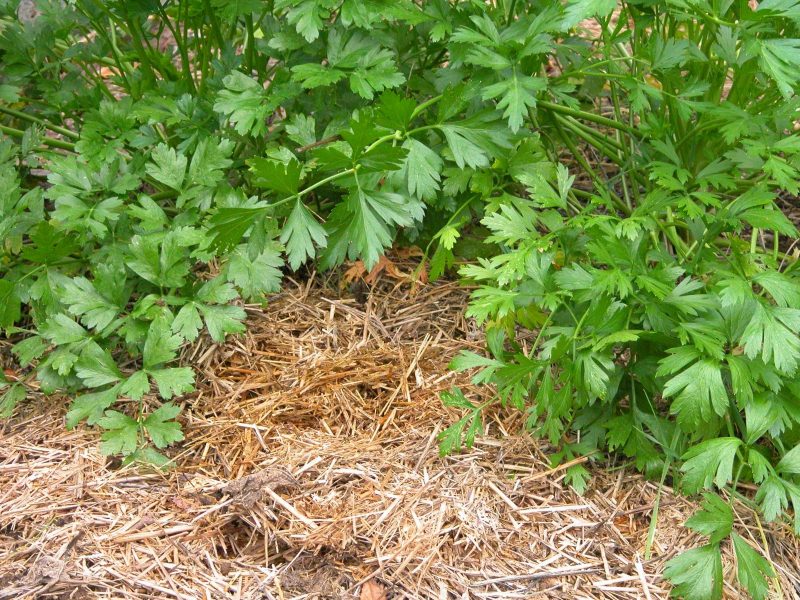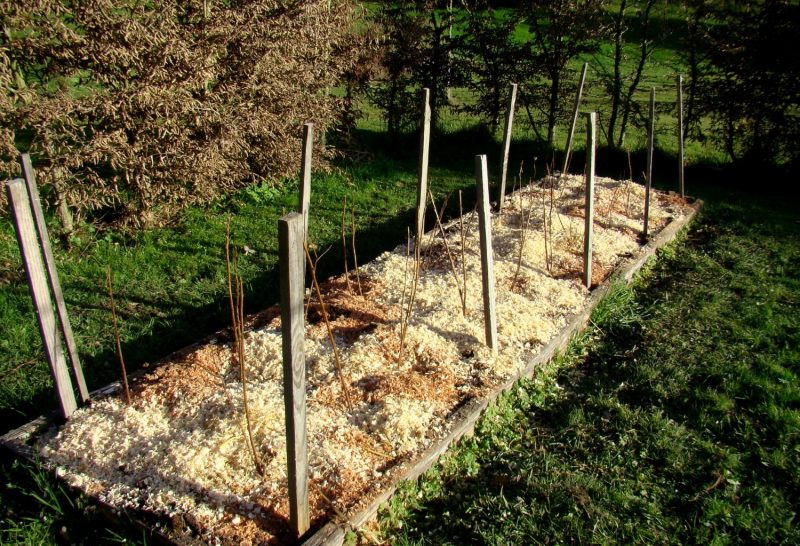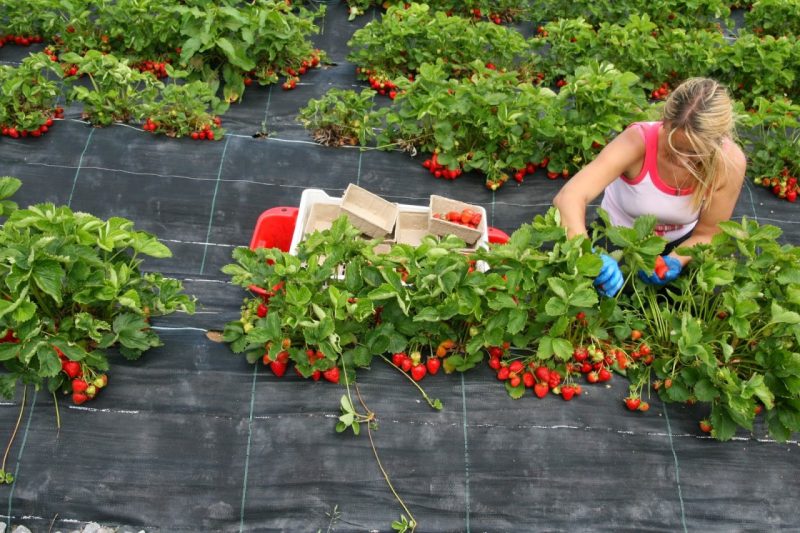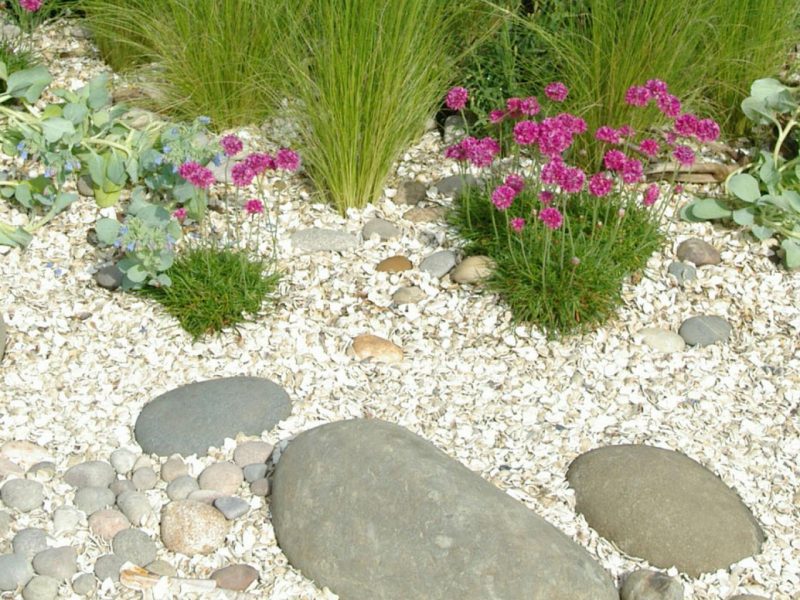Every farmer is familiar with the picture: on a hot day, the gardener runs around with a watering can, trying to water the plants languishing from the heat. It's a shame that in a day or two the whole procedure will have to be repeated - bare earth quickly evaporates water. Another thing is if it is under a mulching layer. Mulching is the surface coating of soil with a variety of materials, both organic and inorganic in origin.
Material Content:
Mulching the soil - what is it?
In the wild, no one loosens the soil and does not fertilize plants, but the height and strength of many herbs can be envied. The annual natural mulching of the soil contributes to such growth. Fallen leaves and wilted stems of plants cover it with a layer of organic matter, which rots and fertilizes the earth, preserving fertility.

In our beds we achieve complete order. To do this, weed out all the weeds and take them away from the garden. We do the same with crops that have finished vegetation. Those. annually, part of the nutrients contained in the soil and spent on the growth and development of cultivated and weed plants is not returned to the soil. Her fertility is steadily declining. As far back as the 17th century, observant gardeners made the appropriate conclusions and began to cover the ground with buckwheat straw. These were the first attempts to mulch the soil.
In modern gardening and horticulture, the practice of sheltering land with various materials of organic and inorganic origin is widely used. Why is this done?
The need for the procedure

Mulching the soil, the gardener receives undoubted benefit.
- Moisture evaporation is reduced, thereby reducing the frequency of watering.
- The loose soil, which does not compact under the mulching layer, is well aerated, creating comfortable conditions for the root system.
- Significantly reduced weed growth, there is no need for weeding.
- The temperature regime is stabilizing, as the soil heats up and cools more slowly.
- The conditions for the life of earthworms and beneficial microorganisms are improving, therefore, soil fertility is increasing.
- Organic mulch, decaying, increases the content of humus in it.
- In winter, the soil freezes less, in the spring it is ready for cultivation and sowing earlier if you move the mulch layer from the bed and let it warm up. Mulching strawberries in autumn saves the surface root system of plants from freezing. In the same way, all plants whose roots can suffer from frost in the winter are mulched: roses, grapes, and fruit trees in regions with harsh climates.
- All pathogens located on the surface soil layer are reliably isolated from plants.
- The soil under the mulching layer is not subject to erosion.
- In flower beds, mulch can also play a decorative role, emphasizing the individuality of flower arrangements.
The disadvantage of this procedure can only be called its complexity. But if you calculate how much time the farmer frees up for other urgent matters, then it’s not a pity to work hard.
It is necessary to begin to mulch the soil in late spring, when it has already warmed up, but has not yet lost the moisture accumulated during snow melting.
Sometimes it is difficult to find enough organic matter to cover all the beds with it. We will try to broaden the horizons of the gardener and help him find mulching materials where he did not count.
What materials are used for mulching?
As a mulch, you can use any material that passes moisture and air to the roots of plants.
Sawdust, shavings, chips
Often, gardeners use mulching on the floor or completely rotted sawdust, for fear of using fresh ones. But they are quite suitable for these purposes, if they are not mixed with soil. In this case, nitrogen losses, which the farmer fears, do not occur.

But if doubts remain, you can prepare sawdust for mulching as follows.
- Spread a large plastic film on a flat surface.
- Pour evenly 3 buckets of sawdust.
- Sprinkle them with urea in an amount of 200 g, distributing it evenly.
- Pour a bucket of water.
- Layers repeat.
- Cover the sawdust on all sides with a film.
After 2 weeks, the prepared mulching raw materials can be safely used. There will be no nitrogen loss, even if the sawdust is mixed with soil. The best result is obtained if you combine them with half-ripened compost.
For mulching, it is better to use medium-sized particles. Filings that are too small tend to cake. You can use production waste from any wood species, except oak, but obtained by sawing chipboard or fiberboard are categorically not suitable - they have harmful substances.
Sawdust from coniferous trees is especially good for mulching strawberries or carrots. Phytoncides, which are released by coniferous wood, scare away many pests. They are not liked by slugs, snails, weevil, carrot fly. Berries on mulched beds are always clean and easy to pick. When mulching a strawberry plantation with fresh sawdust, it is good to lay a double layer of newspapers under them. The thickness of the mulching layer is from 3 to 5 cm.
Shavings or wood chips are more suitable for mulching near-tree circles of trees and plants in flower beds.The mulching layer must be located no closer than 10 cm from the trunk. Its thickness is up to 7 cm for fruit and up to 5 cm for flowers. It is better to let shavings and slivers lie for about a month before use, so that the harmful phenols contained in the wood disappear.
When using wood waste as mulch, remember that it affects the acidity of the soil. Coniferous waste acidifies it, so it is better to use it for those plants that are comfortable in acidic soil.
Mowed grass
It is a perfectly suitable material for mulching. You need to mow the grass before flowering so that the seeds of weeds that can ripen do not clog the beds.
Features of mulching with mowed grass.
- Before use, the grass is slightly dried, fresh - can rot.
- Before mulching, beds need to be freed from weeds and watered.
- The grass is not laid close to the plants, the stems should remain free space.
- A layer of grass mulch is from 5 to 7 cm. As the grass dries, the grass needs to be added.
- On perennial plantings, the grass is left for the winter. From the beds on which annuals grew, they clean it.
Coniferous bark
This durable material has all the necessary properties to become a mulch. In addition, it is very decorative and will be the decoration of the flower garden, being a good restrained background for bright flowers.
Most often, the bark is crushed, but if garden design requires it, you can use large pieces. Great for mulching larch bark. Due to the bright, but not intrusive color, it looks good in flower beds.
When mulching with bark, a layer of thick paper or a little mowed grass should be placed under it. The thickness of the bark layer is from 5 to 7 cm. When mulching with this material, nitrogen and phosphorus fertilizers must be added to the soil, since the bark reduces their content in the surface layer.
Needles, conifer needles
Those who have pine trees on the plot are lucky. They don’t need to go to the forest to stock up on needles - an excellent mulching material for many garden and ornamental crops. For rhododendrons and conifers, pine needle mulch is simply a godsend. Roses, hydrangeas and other acidophiles also love her. In the garden, pine needles can be used limitedly - only for those plants for which the increased acidity of the soil will not become a problem. These are: potatoes, tomatoes, pumpkins, cucumbers, carrots, salads. You can mulch with coniferous litter and strawberries, but do not do it annually or combine mulching with the application of ash. This also applies to other cultures.
Spruce litter for mulching is less suitable, as it can slow the development of many plants.
Straw
This material is able to create a wonderful mulching layer. Stack it with a layer of up to 15 cm, leaving a space around the stems of plants. Loose material compacts quickly. The result is a mulch with an optimum thickness of up to 6 cm. The straw rotes slowly, drawing nitrogen from the surface layer, so nitrogen-containing fertilizers will have to be applied more often. Over time, the straw layer will have to be added, and to maintain friability and shake a little.
For which crops is straw mulch best suited?
- Basil. When mulching with straw, its taste improves.
- Blackberries mulched with this material can give a three-fold increase in yield.
- Raspberry responds well to straw mulch, but it is necessary to provide for the possibility of new shoots to grow.
- Crops of currants and gooseberries increase, bushes become healthier, and there are fewer pests on them.
- Winter garlic. Heads are larger and of better quality. Mulch the beds in the fall after planting. In mulled garlic, the ends of the leaves will not dry out in spring.
- Potatoes. When using straw, you can do without weeding and hilling.Such potatoes are always smaller than the Colorado potato beetle, since it is difficult for it to overcome the mulching layer and come to the surface after wintering. Mulch the potatoes with straw immediately after germination.
- Cucumbers Mulching in the open field gives a good result. For the greenhouse, this method is not suitable - plants can get powdery mildew.
- Tomatoes and other nightshade. Straw protects them from diseases of anthracnose and leaf spot.
All of the above about mulch with various organic materials is true for all types of soils, except clay soil. There is a separate rule for them.
The thickness of any mulching layer for clay should not be more than 2 cm, otherwise it will adversely affect the growing conditions of plants.
In addition to mulching with organics, synthetic materials can also be used.
Synthetic mulching
It has all the advantages of organic mulch, except for one: synthetics cannot enrich the soil with nutrients and humus.
Film
For mulching, a film no thinner than 30 microns is suitable, and for perennial crops it is better to choose a film with a thickness of up to 60 microns. An important point is the light transmission of the material. The more light it transmits, the more active will be the growth of weeds. Ideally, it is best to use a black film that completely reflects the light.

Mulching films are produced in several types:
- black is an excellent choice for temperate regions; in the south, plant roots under such a film can overheat;
- two-layer - black below, white above - ideal for any climate, they provide optimal temperature conditions in the root zone, and weeds under them do not survive;
- multi-colored - silver, orange, red.
Tomatoes, mulched with a red film, give tomatoes that have a rich and vibrant taste.
To mulch the film was effective, you must follow certain rules.
- Dig the earth, fertilize and be sure to align well.
- The bed is formed and moistened.
- Cover with a film, which is tightly pulled and well fixed.
- Holes are made at the right distance, and plants are planted.
Special fabrics

These include: agrotex, spanbond, agrospan, lumitex, lutrasil, agril. Compared to films, they have certain advantages: they can pass moisture and air. To prevent weeds from developing, black synthetic fabrics are chosen. They are used in the same way as mulch films.
Inorganic mulch
Most often it is used in flower gardens and serves as an element of garden design. For it, any crushed stone or gravel, ceramic chips and synthetic plastic granules are used. The main functions of inorganic mulch: weed control, moisture preservation and temperature regulation. When using it, you need to remember that in the sun the stones can get very hot, but at night they give heat to plants for a long time.

Mulching the soil is not a whim, but a vital necessity, without which the labor of a gardener can turn into hard labor. The comfort that mulch creates for plants significantly increases their yield. Namely, this is what every farmer seeks.












